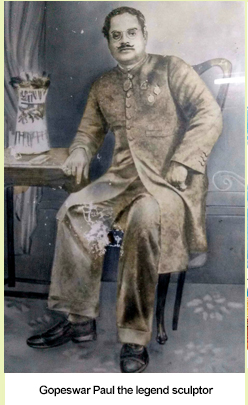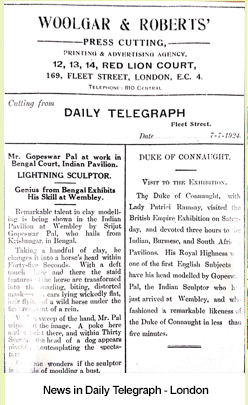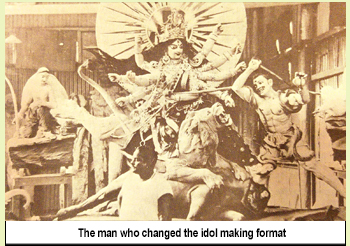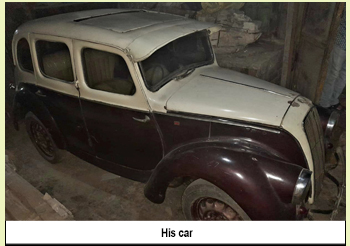Gopeswar Paul : The man who redefined the craft of idol making
The Statesman dated 13th October 2023
 The art of crafting idols in Bengal has always possessed a unique and distinct character, setting it apart from other regions in India. Bengal's abundant reserves of soft and pliable clay harmoniously combined with the boundless
creative imagination of sculptors. They fearlessly applied their ‘Midas touch’ to celestial figures, birthing an entirely new school of idol making during the mid-18th century, coinciding with the surge in popularity of
Durga Puja celebrations during autumn.
The art of crafting idols in Bengal has always possessed a unique and distinct character, setting it apart from other regions in India. Bengal's abundant reserves of soft and pliable clay harmoniously combined with the boundless
creative imagination of sculptors. They fearlessly applied their ‘Midas touch’ to celestial figures, birthing an entirely new school of idol making during the mid-18th century, coinciding with the surge in popularity of
Durga Puja celebrations during autumn.
This tradition continued for well over a century and a half, gradually giving rise to two distinct streams of clay modeling for Durga idols. These were named Kangshanarayani and Bishnupuri. The idols in both schools were adorned with vibrant and resplendent backgrounds known as "Chalchitra," the selection of which depended on the idol's size and height.
These "chalas" came in various forms and designs, bearing names like Brindabani Chala, Indrani Chala, Bramhani Chala and Kailashi Chala. Community Durga puja started in Calcutta in 1918, and in the next 10 years, its number increased at a high pace.
In 1932–33, Kumartuli Sarbojanin Durga Puja organisers contacted a man to make an idol for them. His name was Gopeswar Paul, a man in his early 30s who, despite hailing from a family of idol makers in Krishnanagar, Bengal, was far from an ordinary craftsman. He, unlike other professional idol makers, was a distinctive sculptor dedicated to contributing to the art of modern realistic form, profoundly influenced by the European style of model making. By that time, he had international fame, and his name was in the headlines of many newspapers in London. His extraordinary skill of shaping human and animal miniature forms with clay won him the title “The Lightning Sculptor,” and this crown title was
awarded to him by none other than Lord Charmichael, the Governor of Bengal, in 1915.
In July of 1915, Lord Charmichael was visiting Nadia district and came to see the village of Ghurni, which was the abode of many noted clay model sculptors. During his visit to the renowned sculptor Jadunath Pal, he encountered a remarkable sight. There, he witnessed Jadunath's young nephew, a mere 17 years of age, skillfully moulding a small, lifelike head of the governor from a raw lump of black clay in a matter of minutes. The governor was so deeply impressed by this display of talent that he bestowed upon the young boy the title of "lightning sculptor”.
 The event changed Gopeswar Paul’s life forever. Nine years later, in the year 1924, there was an international art exhibition in London. Known as the British Empire Exhibition, this international event was meant to display some of
the finest forms of art created by artisans across the world. Thanks to the cordial initiative of Lord Charmicheal, whom a young Gopeswar mesmerised with his magical fingers in 1915, and the strong recommendation of Percy
Brown, the Principal of the Government Art College of Calcutta, Gopeswar received an invitation to attend it as the only Indian clay sculptor. The event changed Gopeswar Paul’s life forever. Nine years later, in the year 1924, there was an international art exhibition in London. Known as the British Empire Exhibition, this international event was meant to display some of
the finest forms of art created by artisans across the world. Thanks to the cordial initiative of Lord Charmicheal, whom a young Gopeswar mesmerised with his magical fingers in 1915, and the strong recommendation of Percy
Brown, the Principal of the Government Art College of Calcutta, Gopeswar received an invitation to attend it as the only Indian clay sculptor.
 Braving much social stigma for crossing the sea, Gopeswar, then a young man, just got a place in Calcutta’s Kumartuli area with the help of one Radha Kisan Sonthalia. After working a few years at Burn & Company, Asansol, he boarded the ship to Europe with two barrels full of clay meant for idol-making. During his voyage, he made a few small miniature statues and gifted them to the captain and other sailors of the ship. They were so delighted to get those unusual gifts from an unknown Indian that they upgraded him to first class from third class. It proves Gopeswar won the heart of Europe even before he touched its shore. The venue of the exhibition was the prestigious Wembley, where Gopeswar got a small corner at the Bengal court of the Indian pavilion, where one day the Duke of Connaught, who was the son of Queen Victoria, paid a visit with his daughter Patrisia Ramsay.
Gopeswar, present at the exhibition place with a basket full of small Bengali clay dolls, did his magic once again. Braving much social stigma for crossing the sea, Gopeswar, then a young man, just got a place in Calcutta’s Kumartuli area with the help of one Radha Kisan Sonthalia. After working a few years at Burn & Company, Asansol, he boarded the ship to Europe with two barrels full of clay meant for idol-making. During his voyage, he made a few small miniature statues and gifted them to the captain and other sailors of the ship. They were so delighted to get those unusual gifts from an unknown Indian that they upgraded him to first class from third class. It proves Gopeswar won the heart of Europe even before he touched its shore. The venue of the exhibition was the prestigious Wembley, where Gopeswar got a small corner at the Bengal court of the Indian pavilion, where one day the Duke of Connaught, who was the son of Queen Victoria, paid a visit with his daughter Patrisia Ramsay.
Gopeswar, present at the exhibition place with a basket full of small Bengali clay dolls, did his magic once again.
In a mere 45 seconds, using a soft piece of clay, he crafted the likeness of a horse's head and then skillfully transformed it into a distorted mask. He promptly reshaped the clay into the form of a car, leaving all present spectators
astounded. To their amazement, he then turned this small piece of clay into an incredibly lifelike likeness of the Duke of Connaught, much to the disbelief of the Duke, other members of the royal family, and the entire audience.
His exceptional skill left everyone, including the Duke's daughter, Patricia Ramsay, who purchased small clay dolls from Gopeswar's stall, spellbound.
The next day, London newspapers were flooded with reports of this captivating experience of the Duke, and out of that, the Daily Telegraph paid the best tribute to Gopeswar. On 7 July 1924, it made headlines for the event by saying “Lighting Sculptor: A Genius from Bengal Exhibits His Skill at Wembley”.
 By giving vivid details of every single magical creation that Gopeswar made before the crowd, it went on to write, “Remarkable talent in clay modelling is being shown in the Indian Pavilion at Wembley by Srijut Gopeswar Pal, who hails from Krishnagar in Bengal... Someone wonders if the sculptor is capable of moulding a bust. Gopeswar won the gold medal and other top recognitions of the exhibition. By giving vivid details of every single magical creation that Gopeswar made before the crowd, it went on to write, “Remarkable talent in clay modelling is being shown in the Indian Pavilion at Wembley by Srijut Gopeswar Pal, who hails from Krishnagar in Bengal... Someone wonders if the sculptor is capable of moulding a bust. Gopeswar won the gold medal and other top recognitions of the exhibition.
A huge certificate was issued to him by the Royal family and the organisers of the exhibition. The certificate can still be seen on display at his studio at 40A Kashi Mitra Ghat Lane in Calcutta.
During his stay, Gopeswar made several visits to many museums in London, including the London Zoo. While in every museum he studied the details of stone carving, paintings, and sculptures of human figures in pure European style, in the zoo he used to observe the movement of lions, tigers, snakes, and other animals. He used to study the facial expression and body movement of the animals for hours, and with his sheer hard work and imagination, he started to shape them
up in clay.
 From London, he visited some cities in Italy, where his exposure to European schools of modelling was enriched. There in Italy, he studied a formal course in the modelling of sculpture and collected some important books on the subject. From London, he visited some cities in Italy, where his exposure to European schools of modelling was enriched. There in Italy, he studied a formal course in the modelling of sculpture and collected some important books on the subject.
After spending many months in a few European countries, when Gopeswar returned to India, he was a changed man with matchless wisdom in his field. Gopeswar had no aim of becoming a common Durga idol maker like other artisans in Kumartuli. Though he took a plot there in 1926 and built a modern studio with all possible facilities of that era, he put his concentration mostly on human figures in European style. He had clients in many rich and royal families in India.
When he got the offer to make a Durga idol for Kumartuli Sarbojanin puja in 1933, he charged Rs 3,000—an unimaginable remuneration that an idol maker can think of. However, this high fee was not just for his international
status but for a revolutionary idea that Gopeswar took away from the shores of England and Italy. He broke the traditional one-cluster form of the Durga idol. Rather than positioning all five celestial figures on a single pediment,
he divided them into five parts, each housing one deity. The conventional 'Ekchala' Durga idol was transformed into five distinct 'chalas.' Additionally, he departed from the traditional portrayal of Durga's face, characterised
by oversized eyes and bright yellow skin. Instead, he crafted the visage of each goddess to resemble that of an ordinary human being. Notably, he deliberately depicted Lakshmi and Saraswati with younger and more youthful appearances, as they are considered the daughters of Durga.
 Gopeswar made it noticeable that the age of Durga and the age of her daughters are not the same. He created all the sculptures and ornaments of the idol in clay only and gave a complete new look to all the animals featured in
the idol. Gopeswar’s rich experience of observing lions, snakes, and wild bison in London and the Calcutta Zoo is clearly reflected in his idol. Gopeswar made it noticeable that the age of Durga and the age of her daughters are not the same. He created all the sculptures and ornaments of the idol in clay only and gave a complete new look to all the animals featured in
the idol. Gopeswar’s rich experience of observing lions, snakes, and wild bison in London and the Calcutta Zoo is clearly reflected in his idol.
Now the controversial question comes: In which year did Gopeswar first do his revolutionary work for Kumartuli Sarbojanin Durga Puja? Most people are of the opinion that it was 1933, but Anita Agnihotri wrote in her book that it was 1937. She even wrote that much before Gopeswar, some artisans in East Bengal experimented with the craft of splitting ‘ekchala’ into five different ‘chala’. The official souvenir of Kumartuli Sarbojonin Durgotsav claims it is from
1939, when their idol was gutted overnight before puja and Gopeswar came forward to make five small idols overnight to save the puja. As per them, it was an accidental beginning by Gopeswar to split the ekchala format of idol. As per Byomkesh Pal, who comes from the family of Gopeswar and now takes care of his studio, it was between 1935 and 1936. In an article written by Geir Heierstad and published on the official page of Cambridge University Press, this year is
mentioned as 1935.
In fact, Gopeswar made an idol for this puja committee for 8 years, but the year in which he split the idol is not properly recorded. The puja organiser to date is not sure about the year, though they have mentioned it in their
published magazine. Nonetheless, the notion that Netaji Subhash Chandra Bose served as an inspiration for Gopeswar Pal in crafting this exceptional idol is purely a myth. This unfounded conjecture is currently circulating on social media, lacking any substantial basis. While Netaji did hold the position of the puja committee's president in 1938 and 1939, he had no involvement in influencing Gopeswar Paul's idol-making process. There is no tangible testimonial
to make this story authentic.
 Gopeswar died in 1944, and before that, he gained all-India fame as the best sculptor to make human figures. He was invited to make statues of many royal families from across India. Author Sarat Chandra Chattopadhay himself came to his studio to give a sitting while Gopeswar made his clay model. The iconic white stone statue of Ramakrishna enshrined in Belur Math is one of his finest works. Gopeswar’s work by RN Mukherjee, made in 1938 and earlier at Dalhousie
Square, is now inside the garden of Victoria Memorial Hall. It gives Gopeswar the honour of being the only Indian whose sculpture is on display inside the Victoria Memorial. Gopeswar died in 1944, and before that, he gained all-India fame as the best sculptor to make human figures. He was invited to make statues of many royal families from across India. Author Sarat Chandra Chattopadhay himself came to his studio to give a sitting while Gopeswar made his clay model. The iconic white stone statue of Ramakrishna enshrined in Belur Math is one of his finest works. Gopeswar’s work by RN Mukherjee, made in 1938 and earlier at Dalhousie
Square, is now inside the garden of Victoria Memorial Hall. It gives Gopeswar the honour of being the only Indian whose sculpture is on display inside the Victoria Memorial.
The studio that he established in 1926 at 40A Kashi Mitra Ghat Street was named "G. Paul & Sons: Modellers & Sculptors”. After his demise, his son, Siddeshwar Paul, owned it. It has been with Siddeshwar’s brother-in-law,
Byomkesh Paul, for the last 50 odd years.
Byomkesh Babu, now in his eighties, exudes an immense enthusiasm when he pays a visit to the studio, nurturing his thirst for history. He leads each guest into the studio, where they can witness a multitude of semi-finished
and completed works by Gopeswar Pal. Byomkesh takes pride in showcasing his vintage car and the cherished certificate awarded to Gopeswar in 1924 from London. In his advanced years, Byomkesh Babu expresses sorrow that this studio, a
veritable treasure trove of our artistic heritage, remains devoid of government support. Despite its heritage status declaration in 2012, no financial resources have been allocated for its maintenance. He points out the pervasive
leakages and cracks in the walls, which pose a significant threat to the preservation of all artifacts within the studio. Additionally, there's a constant menace from anti-social elements.
Gopeswar's revolutionary idol marked his ascent to legendary status during his lifetime. Beyond a rare exception, he seldom ventured into crafting Durga idols, as he recognized the vast realm of creativity awaiting his exploration.
Byomkesh Paul insists that historymust remember Gopeswar Paul as a fully evolved and erudite artist who brought transformation to the traditional depiction of the human form. According to Byomkesh Babu, Gopeswar stands apart from other
commercial idol makers of his era, such as Ramesh Pal, Rakhal Pal, or Gora Chand Pal, all of whom drew inspiration from him but fell short of his stature by any measure.
The author is a freelance contributor.
Click here to view the original article
|



